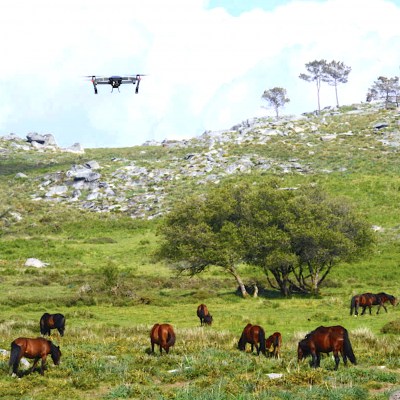Kyoto, Japan -- When testing hypotheses on how horses synchronize their herd behaviors, computational modeling is a must. Much more is happening among the many mares, stallions, and foals than can be summarized by a few simple equations.
"As with humans, horses have much more complex societies than most birds or fish, for which there are many successful studies involving behavioral models," explains research team leader Tamao Maeda.
In the social structure of feral horses, small stable unit groups aggregate into larger herds. This is analogous to human families gathering to form local communities, which further combine to form higher social units such as cities.
The difficulty in observation lies in the animal's size, both in terms of its group population and the vastness of these populations' distribution. The relative scarcity to date in behavioral synchronization studies may be due to such challenges in observing the macroscopic structure of feral horse societies.
Now a joint team from Strasbourg University and Kyoto University have solved this problem using drones to simultaneously observe the spatial structure and herd behavior of one hundred feral horses in Serra D'Arga, Portugal.
Maeda's team used a multi-agent computerized system or MAS, which is appropriate for target surveillance and social structure modeling. In their MAS, they applied different hypothetical rules. Firstly, are individuals independent? If so, foals do not count. Second, do individuals randomly synchronize their behavior, or is there a possible pattern of selection?
Third, and most intriguingly, do individuals synchronize according to their social network? To test this hypothesis, two sub-models were created, one of which only takes into an account the same unit group members, such as in a human clique. The other sub-model applies to the entire herd.
The simulation and empirical data were found to clearly support the last hypothesis, suggesting that feral horses coordinate with other individuals not only within a unit group but also at an inter-unit-group level. Surprisingly, inter-individual interactions occur among spatially-separated horses as well.
This behavior contrasts with most previous studies that have suggested that socially complex animals synchronize the behavior of only a few nearby individuals and that such local interactions then create the global synchronization.
Among the feral horses in the study, however, the average nearest unit distance was 39.3 m while the nearest individual within the same unit was 3.2 m. The team's results suggest that the horses developed an ability to recognize the behavior of even those individuals that were spatially very distant from them.
The researchers are encouraged by the results of these methods combining drones and rule-based models, integrating social relationships in simulating the behavioral synchronization of animals living in one of the most complex societies known outside of human communities.
Research leader Shinya Yamamoto concludes, "As our model is applicable to other animal groups, this study on collective synchronization will contribute to an understanding of the evolution and functional significance of complex animal societies."

【DOI】https://doi.org/10.1371/journal.pone.0258944
【KURENAI ACCESS URL】http://hdl.handle.net/2433/265532
Tamao Maeda, Cédric Sueur, Satoshi Hirata, Shinya Yamamoto (2021). Behavioural synchronization in a multilevel society of feral horses. PLOS ONE, 16(10):e0258944.





